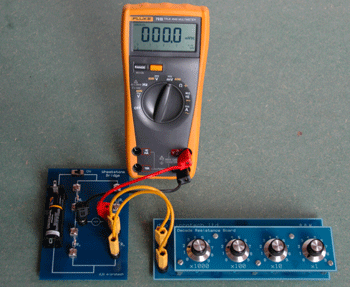 Modern Wheatstone bridge
A simple and Latest wheat stone bridge which is balanced to show a zero reading in the digital multimeter.
Modern Wheatstone bridge
A simple and Latest wheat stone bridge which is balanced to show a zero reading in the digital multimeter.
The Wheatstone bridge is an electrical bridge circuit used to measure resistance.
The Wheatstone bridge network consists of four resistors which are interconnected. If the ratio of the two resistances in first column is equal to the ratio of the two resistances of second column, then the voltage across bridge will be zero.
In Wheat stone bridge, one of these resistors is the unknown, the person being measured, has to obtain a balance, by varying its complimentary resistor to give a 'null' (zero deflection) on the meter. Thus if R1 is the unknown, R4 would be a variable. Also, because there can be a wide range of body resistance depending on weather conditions, health etc, one of the resistors R2 or R3 would have to be a variable to keep in range.
When the bridge is connected in an electrical circuit, part of the current flows to the object whose resistance is unknown (a light bulb in the illustration), and part flows to the resistor of known resistance. If more current flows through one side of the circuit than the other, the galvanometer shows the difference. The sliding contact is then moved along the wire until current flows equally along both sides of the bridge and the galvanometer shows zero.
When the bridge is thus balanced, the unknown resistance is calculated by a formula. The formula is : X = RD'/D (X is the unknown resistance. R is the known resistance. D is the distance from the key to the right end of the meter stick. D' is the distance from the key to the left end.)